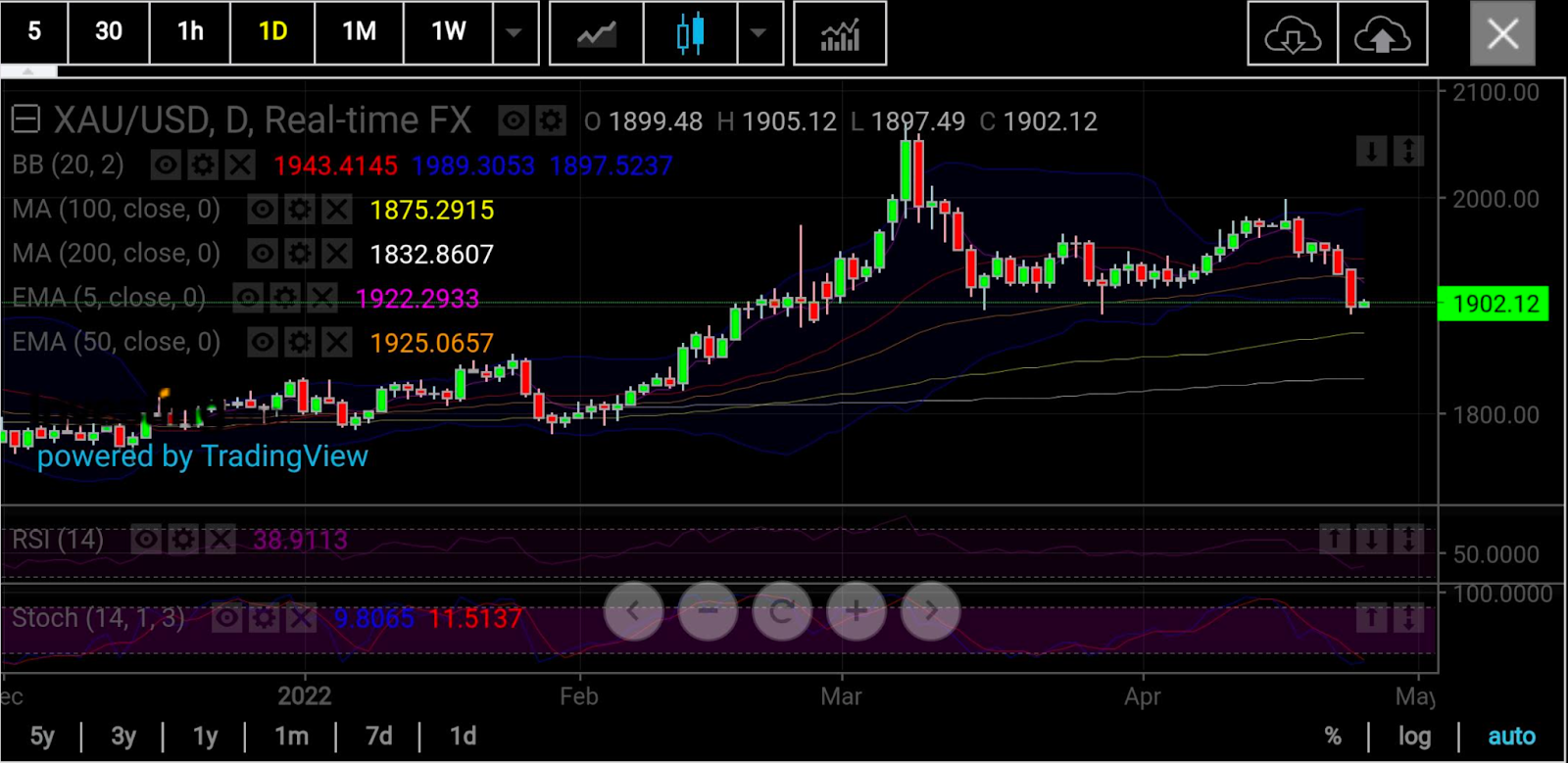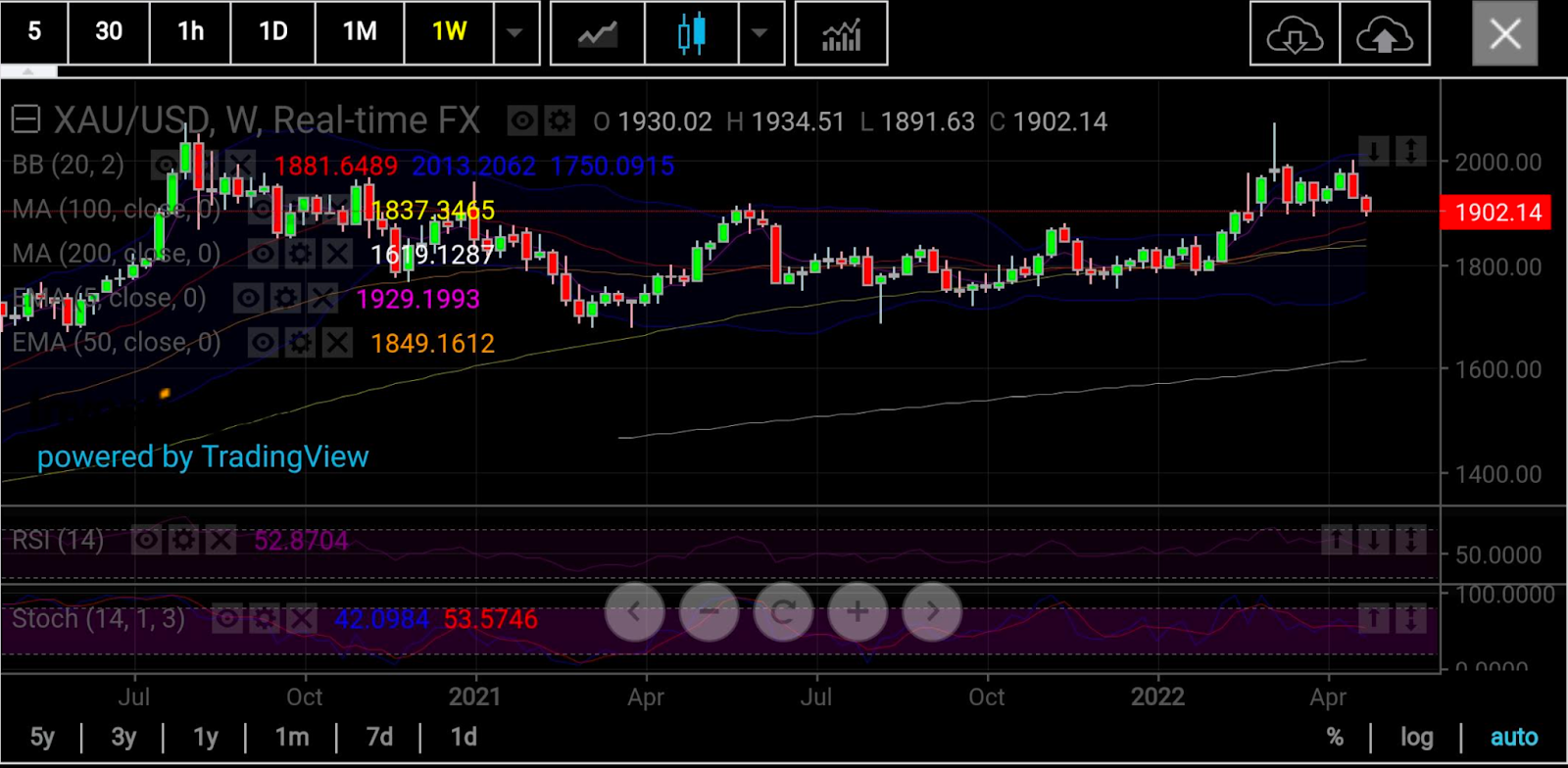A week seems too long in gold now.
Eight days ago, the yellow metal hit highs of above $2,000 an ounce on safe haven buying on fears the Federal Reserve could choke the US economy instead of inflation with the rate hikes it was planning.
Now, gold might stay in a $100 range below mid-$1,900 until the first week of May at least, as the Fed’s repeated assurance that it will not cause a recession has handed power to the dollar—the nemesis to the yellow metal and chief beneficiary of any rate hike.
In Monday’s trade, the Dollar Index, which pits the US currency against six major rivals, hit a 25-month high of 101.745. As Tuesday’s session began in Asia, the greenback slid for the first time in four sessions but nowhere enough to cause a serious setback to its four-week run-up, which, incidentally, gained steam right after gold’s $2,003 high on Apr. 18.

All charts courtesy of skcharting.com
Making the dollar’s run even more pronounced is the sudden stalling of the rally in US bonds, which lost ground last week after an uninterrupted three-week rally. Until Apr. 20, the yield on the benchmark 10-year US Treasury note had been hitting highs since December 2018.
“Even with a pause in the bond market selloff the dollar is not losing any steam and that is bad news for gold,” said Ed Moya, analyst at online trading platform OANDA.
He added:
“Gold prices are stuck in the danger zone until the Fed rips off the tightening band-aid next week. Gold is not attracting flows even on mounting global slowdown fears, as China is potentially poised to have the weakest growth since the early 90s, and as consumer demand destruction becomes more likely later this year. Gold is struggling here and could be vulnerable to further momentum selling to the $1850 level.”
COMEX’s front-month gold futures for June settled down $38.30, or 2%, at $1,896 an ounce on Monday.

The selloff came as the dollar flew on expectations that the Fed would adopt a 50 basis point (bps), or half percentage point, hike at its May 3-4 policy meeting—double the 25 bps, it approved in March for the first pandemic-era US rate increase.
Initially, there had been much worry that the Fed will take an axe to the economy with its most ambitious rate hikes in at least 20 years.
A succession of Fed speakers has, however, soothed some market worries over the past week that the economy could turn negative from the central bank’s attempts to put a lid on price pressures growing at their fastest pace in 40 years.
While fears of a hard landing for the economy have not evaporated, optimism, especially over the sterling labor market, has won over some pessimists. That has sent the dollar rallying, making gold and other safe havens suffer.
As of now, the expectation is that gold could get boxed in until the Fed gets the May rate hike out of the way, and more crucial US data is released this week and next.
Investors across markets will be looking out for preliminary US first quarter economic data on Thursday, with gross domestic product growth for the period likely to slow to 1.1% from 6.9% in the fourth quarter of 2021 due to the Omicron wave of the pandemic at the start of the year.
That will be followed on Friday by the Personal Consumer Expenditures Index, which is the Fed’s preferred inflation gauge. The last reading of the PCE Index showed inflation at 6.4% in the year to February, keeping to its fastest expansion in four decades.
Then, the following Friday, or on May 6, US jobs numbers for April are due.
The last time gold got rejected from $2,070 and fell to $1,890, it was a $180 decline, noted Sunil Kumar Dixit, chief technical strategist at skcharting.com.
“If a similar pattern gets repeated with rejection at $1,998, a $180 decline can push gold down to $1,818,” he said.
Dixit added:
“Looking at the bearish structure on weekly chart, any upward bounce back is very likely to fizzle out and gold may start for a deeper correction, testing $1,875 initially and extending to its correction to $1,845 - $1,832 - $1,818 over the next few weeks.
 But gold also had the potential to rebound, said Dixit.
But gold also had the potential to rebound, said Dixit.
“The oversold condition in the daily stochastic reading of 11/11, however, does call for a short term—and perhaps a short-lived—rebound towards the $1,925 - $1,935 support-turned-resistance area. If gold finds enough buyers above the range to turn this area into a support zone, it can scale up to the next resistance area of $1,960 - $1,970.”
But some think gold could be stuck in a muddy patch until at least another Fed hike in June, where a second half-point hike could be due.
“Gold will have its day in the sun once the majority of Fed tightening has been priced in, but that might not happen until the June 15 meeting,” added Moya of OANDA.
Disclaimer: Barani Krishnan uses a range of views outside his own to bring diversity to his analysis of any market. For neutrality, he sometimes presents contrarian views and market variables. He does not hold positions in the commodities and securities he writes about.
